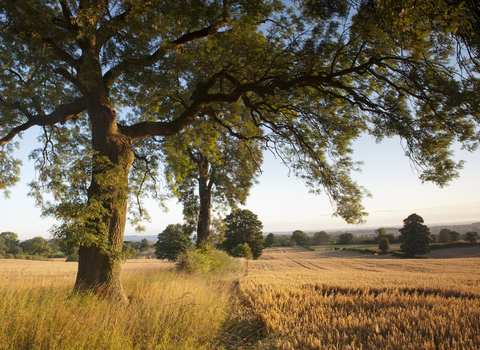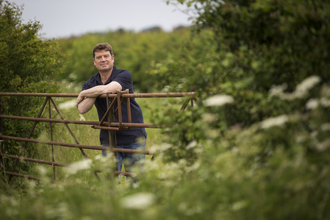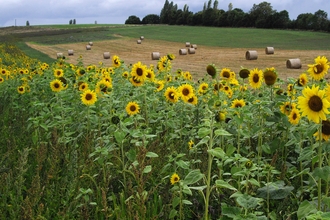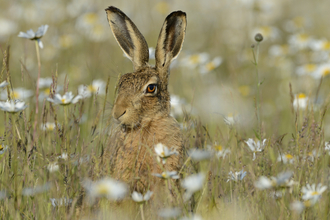I spoke to Caroline Corsie, Senior Land Advisor at Worcestershire Wildlife Trust, and Jonathan Boaz, a Worcestershire-based conservation farmer who works closely with Caroline. With a new Agricultural Bill on the horizon, they share their perspectives on how farming has reached the situation it’s in today, what needs to change to help wildlife and what they hope for the future.
The recovery of wildlife in the UK depends on an Agriculture Bill which enables farmers to create and restore natural habitats, because 70% of all our land is farmed. Wildlife cannot survive in disconnected pockets of wild land, it needs a connected living landscape. Farms are vital for its future.
Where did it all begin for you?
Jonathan
Born in Worcestershire to a farming family in 1949, I grew up in Derbyshire. I remember mountain streams with a profusion of trout and the sound of curlew and lapwings in their hundreds. I remember ring ousels nesting, dippers and skylarks, a wildlife haven. I’ve been closely linked to wildlife all my life.
I left school at 16 to work on an intensive dairy farm in Cheshire. In the post war years there was a need to feed people. When I went to agricultural college and as I began working, there was an emphasis on production of food. It didn’t matter one jot what happened to the environment.
We did unsavoury things. One of my duties was to spread slurry at the refuse tip next to a lovely watercourse that it all went into. I didn’t like the thought of this at the time, but it was standard practice in the 60s. Then I moved back to Worcestershire.
Cereal production began to play a much bigger role in landscapes that were once mostly traditional grassland, due to generous payments by governing bodies to encourage more wheat production. More chemicals became available to combat the various problems associated with crop production. Agronomists started appearing, recommending all manner of toxic concoctions to produce mega crops, but at a cost!
I remember seeing all the dead bees and insects. There were shovels of them.
It became fashionable to spray out a sterile margin round the crop fields to prevent weeds and pests. It was clinical and damaging to so much habitat. All of this was starting the alarm bells ringing in my ears.
We had lost all the wonderful primroses that used to adorn the hedgerows and ditch banks. We were flail trimming hedges to the bone, leaving little to feed and shelter our birds.
Possibly the worst to me as a farmer, was that the soil was starting to fight back. It seemed to need more artificial inputs to maintain production levels. So I started putting grassland back down. I was one of the pioneers putting organic matter back into the soil.
Caroline
I spent most of my childhood growing up on the Isle of Skye, so I was very fortunate. A place where there was no reception for TV or mobile phones. There was freedom for children, a free rein to be out in nature exploring, foraging, and learning the landscape.
I feel that nature takes us out of our current thoughts and into the now. When I was growing up there wasn’t a constant story of gloom and despair like it is today.
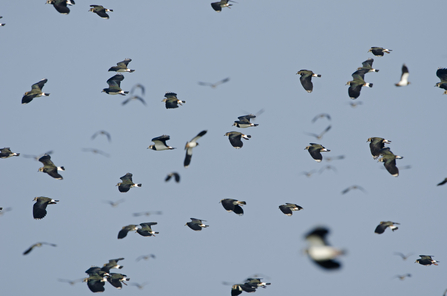
A flock of lapwings. Credit: David Tipling/2020VISION
What inspired you to help wildlife and to do it through farming?
Jonathan
We have a water course running through the farm. It was polluted from residential development as well as from our farm. I tried to address this problem and this is when I first met Caroline through the Parish Council. There were moves afoot to create wetland and block drains. At the time this was not music to my ears as farmers have to make money. We need the farm to make a living. Food production is the start of it. But I listened to Caroline; she’s brilliant. I saw that we have to work together on this.
I went to this meeting and listened to what she said and thought this might work. So, I cooperated with Caroline and we created our first wetland in 2011. It’s been a fantastic success. It’s filtered the water and reduced nutrients. It’s created a completely new habitat for wildlife in there and it wasn’t a big sacrifice.
Caroline
I learned about it at university, studying environmental chemistry. I read Rachel Carson’s book ‘Silent Spring’. The effects of DDT were starting to dawn on me and I saw with horror what one pesticide could do to the planet, people and wildlife. The long reaching effect can still be detected today.
What lead me to help wildlife was a mix of things. I saw that farming helped provide food security but also that wildlife had no protection from the harm it caused. I was once walking in a field in Newbury on chalky soil. The ground then started moving with hundreds of lapwing chicks but that afternoon the farmer intended to roll the fields.
I started as an agronomist in 1981, working within farming to make it greener. At that time the Green Revolution was forced through, but it was nothing to do with nature. There were exciting new products and not much legislation to go with them to protect the health of people and wildlife from their effects.
I specialised in sprayer technology and studied for a Master’s degree in applied entomology. I looked at integrated farming that used the chemicals in a better and safer way for the environment. I worked for a big agricultural business which was all about making more sales, but my approach meant selling less. They asked, ‘Why should we give you a bonus when you’re not selling?’ I resigned, as I was not changing things from within.
I ended up at Worcestershire Wildlife Trust because they wanted someone who could understand the farmer’s perspective and be accepted by them.
What are you doing to help wildlife?
Jonathan
Digging out ponds and wetlands and scrapes. Some are for Stewardship Schemes and some are off my own back. I planted hedges and added multiple species to the existing monoculture hedges. I’m encouraged to plant blackthorn for brown hairstreak butterflies. We need all the berries and multi-coloured hedges, we need diversity for wildlife. People get the idea that farmers are paid a fortune to do this, but it doesn’t even cover the costs.
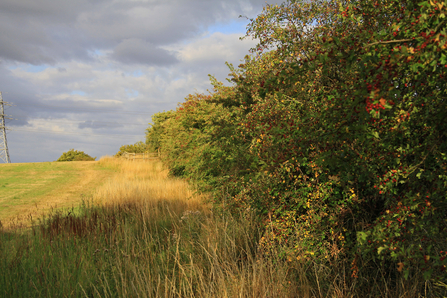
Lower Smite Farm. Credit: Wendy Carter
Caroline
I am lucky enough to manage Worcestershire Wildlife Trust’s farms, including Lower Smite Farm. I've been doing it for the last 13 years. I fully use all my skills in farming and conservation to deliver our message. I’m promoting living landscapes and mechanisms to achieve them, and I signpost farmers to solutions.
The Facilitation Fund project involves 35 farmers. My project focuses on wild pollinators and is a mechanism for bringing farmers together. It’s about improving soil health, water quality, managing flood risk, and working for wild pollinators at landscape-scale. Their work includes creating species-rich grasslands and wetlands, using grazing cattle to create habitat and stopping using chemicals to improve productivity.
It’s essentially about making things good for invertebrates on the farm but not at the farmer’s expense. I listen to the farmer’s description of their enterprise; what they want to do and the help they need. Most say they want help with managing agri schemes and stewardship. They want direction. They want help navigating the huge amount of legislation and paperwork so they can do the right thing while generating a fair return.
I try to establish where they are, the size and location and signpost what might suit them. I sit with them and do the maths, look at laws, look at paperwork and the finances and I’ll tell them a figure they’re guaranteed to be paid. Skilled advisors can do that in a couple of hours.
Baling legume herb mix at Lower Smite Farm. Credit: Caroline Corsie
At Lower Smite Farm, we’re a small farm and we cooperate with small farm neighbours. We’re not a nature reserve but we maximise stewardship schemes and focus on conservation. We prioritise soil health and halting decline in invertebrates. We are doing that by growing herb mixes. We don’t invest in livestock; we provide our neighbours with forage, they give us back manure. We work with four or five farms to try to reduce pressure for all of us. There’s no need for any of our group of farms to invest in machinery.
The guiding rule in all these relationships, ultimate thing, is that it has to be a win-win for farming and for wildlife. We grow wheat with skylarks in mind; there’s no point gaining money if we lose the skylark. We don’t grow rye grass because it doesn’t help soil health. We want diverse mixes to hold moisture.
What are the challenges?
Jonathan
The neighbouring farm was taken over by a factory farm organisation and straightaway they cut all the hedges and trees back and ruined it for wildlife. All my good work is being destroyed by people like that, and if my farm falls into the wrong hands it could happen here. If people are financially motivated, they can make the most money by pillaging the land. It has to be addressed.
When you dig a pond it stops counting towards the area on which you receive basic payments. I’ve fenced off areas for conservation, so I’m not getting that money that I would have received if I'd left them in production.
There is a stigma in agriculture that environmentalists should be avoided at all costs because they don’t have our interests at heart. But they do, as they want to save our planet! Working with Caroline is great, there needs to be more cooperation like this.
Caroline
Stressed farmers. Very stressed and enveloped by bureaucracy and inspections. An issue is the complexity of schemes that are designed to help them and farming and wildlife. Farmers fear making mistakes and they don’t have trusted advisors, but they need the help to deliver. It’s not that the will isn’t there. They are boxed in, having to apply every herbicide under the sun because of resistance. The farmers don’t like that anymore than we do.
With the Wild Pollinator project, the challenge can be keeping people’s enthusiasm going. Sharing my knowledge is a joy. Mostly the challenges aren’t the farmers, it is finding the right equipment, mentally or material, to approach the farmer to make it worthwhile for them.
A significant challenge is the system itself which is lacking in substantial solutions. Hence the high hopes for the idea of public payment for public goods being established as a fundamental principle in the Agricultural Bill. With that approach the money won’t all go to large farms but will help small ones. Small farms are really important. We’re working hard to ensure there’s a voice for the small farms too, so the big ones don’t suck up all the money.
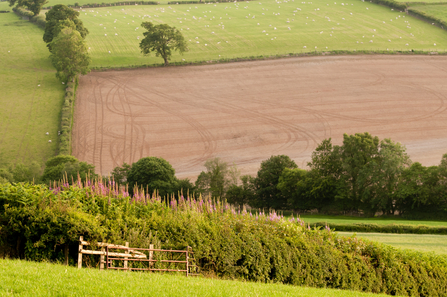
Credit: Ross Hoddinott/2020VISION
One of the big challenges is rewording the message that farmers receive through training and advice. It’s not about output at all costs. The payments for delivering wildlife and habitat need to be equal to or greater than what they'd be paid for producing more food. Farmers need long term contracts and need to know where to start to bring nature back.
Wildlife is like us. Animals need secure food supplies, a safe place to overwinter and shelter, to find mates and reproduce and not to be stressed. The farm in many places is not a functioning ecosystem; it's not providing all these things. The Green Revolution completely wrecked our soils. Healthy soil is fundamental to a healthy ecosystem, so there’s a real difficulty for farmers. We need to improve the soil. It's an asset enhancement, but it costs, so farmers need to see a return on that asset quickly once they've improved it. At the moment so there’s no incentive for them to make this investment.
How does it feel to see the changes you’ve helped create?
Jonathan
It’s a pleasure to walk round the farm seeing the wildlife like barn owls and lapwings.
So much pleasure can be derived from quietly sitting and watching as the birds make use of the bird boxes I put up. For me, this is an aspect of my job it is impossible to put a price on, sharing our countryside with the things that make it what it is, the wildlife.
Caroline
It makes me feel fantastic. I get a tingle down my spine to see the positive changes and seeing farmers doing stuff off their own back, and really valuing what they do. I really hope we recognise the care those farmers take, and empower them. We all want to make things better in the world than when we arrived. The best part of my job is sitting down with farmers who work with the Facilitation Fund and running the pollination health check on their farms, showing them the difference they are making.
A trial bumble-bird mix at Lower Smite Farm. Credit: Caroline Corsie
How is it working together as a partnership?
Jonathan
Caroline and I are the best of friends and we argue like cat and dog! Our objective is the same but the route to get there is different. Lower Smite Farm leads with wildlife conservation, not production. Most farming has to be the other way round.
Caroline
Jonathan has gone streets ahead because he wants to leave things better. He’s a businessman who worked out ways of making compost and making wetland within his business. We’ve put in for funding to create species rich grassland to enhance soil organic matters and to use sustainable drainage management with a natural approach. Using wetland to filter field drains so the runoff entering brooks has less phosphates and pesticides.
How can government help?
Jonathan
We haven’t set out to poison the planet. We’ve done what they told us to do. They need to help us to do thing differently. And they need to recognise that earning a living from farming is not an administrative exercise. The environment is very different to the Whitehall office. The weather can be too wet or dry, and crops fail. Government need to understand that agriculture is not a charitable organisation and that we need good, practical support.
The advisors and inspectors totally lack practical experience. There are things that won’t work in practice. I can explain why they won’t work but the advisors don’t know this because they’ve never done it. One criteria for farm advisers should be to spend a couple of years working on a farm to get a feel for it.
The inspectors measure everything on the farm to the millimetre. We don’t have the measuring equipment they use. We step it out, but they have high spec stuff. I had an inspection where he checked every mortal detail, it took so much time and there was nothing to find. And they want to turn up at short notice which often doesn't fit with what you're doing.
We need to have a set of rules that can be tailored for each advisor. They need to have flexibility and be in tune with every farm. They should look at it on individual farm basis not even at county level. They’ve got all the technology to do it now, so they could achieve much more doing that.
Caroline
Farmers need to be treated as an inexorable part of nature networks. Government should require production of clear long term plans where farmers and growers and conservationists have been involved in deciding how we can create a living and productive landscape together. This really takes us into public goods. Food production shouldn’t be at the cost of conservation and vice versa.
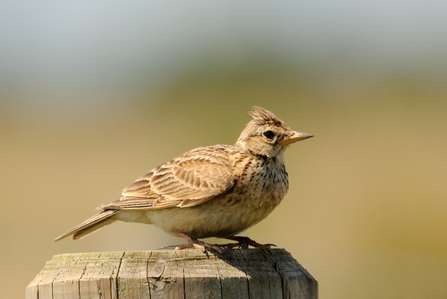
Skylark. Credit: Amy Lewis
What do you plan to do next?
Jonathan
I will badger people that are responsible for funding this work to make sure it is delivered to myself and other farmers. I want to make sure this money is actually used to benefit wildlife. I like to think if I have an idea, I get stuck in and do it and achieve it. Don’t talk about planting a hedge, actually plant the thing. I’ll keep doing what I’m doing, but I’m getting short of ground I can take out of production.
Caroline
Now we take farmers to see what our farmer members of the Facilitation Fund are doing out there. Half of Lower Smite farm is organic, but we want to show that it’s not the only way. For example, we show them fruit farms. We talk about a middle ground where nature works with us, using less pesticides. We focus on showing soil health restoration.
What future do you hope to see for farming and wildlife in the UK?
Jonathan
It’s got to be middle of the road. Good quality food and using some chemicals that are regulated more and ban the awful products. There should be a national scheme. We need more people like Caroline, advisors from a farming background that help a group of farmers and allocate money to spend on environmental improvements. The advisor and the farmer should agree how this will work.
It’s about having 80% for people and 20% for wildlife sanctuaries, where for wildlife can go. That’s what I want to do, but I can’t afford to do it by myself.
We need to understand and appreciate other people’s points of views if wildlife is going to gain. We need one another. Wildlife needs us all.
Caroline
Some farmers say we don’t farm like them at Lower Smite but it requires all of us to create a balanced landscape. No one person is right or wrong, we need to link together. Farmers need to be able to budget for more than 2 years ahead so they have the confidence to take action on things that will take years to yield their greatest benefits.
We want more skylarks! Farmers want more time because they are tired! We can show that we have already approached farmers with opportunities they might like. The government can see the sense behind what we are saying but now we must be able to deliver.
“We need to understand and appreciate other people’s points of view if wildlife is going to gain. We need one another. Wildlife needs us all.”
A new Agricultural Bill needs to make a break with the past, enabling all farmers to help wildlife as part of the work they do every day. Agriculture policy does not have to choose between wildlife and food production. Farming that works with nature makes sense – for now and for the future.
Written by Sally-Ann Smurthwaite, Internal Comms and Stories Officer.

